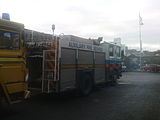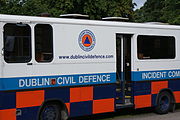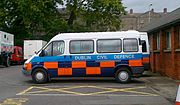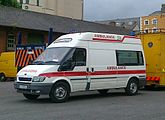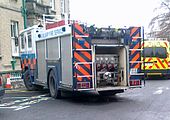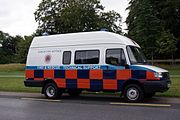- Civil Defence Ireland
-
Civil Defence Ireland 
Status Active Territory Republic of Ireland Leadership Civil Defence Board Appointment Minister for Defence & Local Authority Founded 1950 HQ Roscrea, County Tipperary, Ireland Website http://www.civildefence.ie 

The international distinctive sign of civil defence, defined by the rules of International Humanitarian Law and to be used as a protective sign Civil Defence Ireland (Irish: Cosaint Shibhialta na hÉireann) is the national civil defence organisation of the Republic of Ireland. It is operated at local authority level in conjunction with the Department of Defence.
The organisation was established in 1950 in response to the threat of nuclear disaster posed by the atomic bomb following World War II or "The Emergency" as WWII was known in Ireland. Its purpose was to provide aid, assistance and disaster relief to citizens in time of emergency. Today, the organisation runs on the same principal with a focus on effectively aiding the full-time emergency services as and when required.
Contents
Organisation Structure
Civil Defence Ireland is composed almost entirely of volunteers, with the exception of the local authority-appointed Civil Defence Officers, Assistant Civil Defence Officers, administration, maintenance and stores personnel. The organisation provides six different services to the community, primarily acting as an auxiliary resource for the front-line emergency services, particularly the fire brigade rescue and ambulance service who may utilise the organisation's manpower, skills and equipment when requested.
Civil Defence Ireland - Rank Structure








CD Officer Asst.CD Officer Commander 1st Officer 2nd Officer 3rd Officer Leader Asst.Leader Civil Defence Services Auxiliary Fire Service Trained in firefighting, rescue and flood relief. Search and Rescue Service Trained to rescue individuals in emergency situations and search for missing persons. Ambulance/Casualty Service Providers of emergency care at different levels in emergencies or at event cover. Welfare Service Provide care, comfort and shelter for citizens in emergencies. Warden Service Provide radio communications networks and monitor for radiation. Water Rescue Unit Primarily crewed by the Rescue Sevice as well as AFS firefighters . Inshore and river rescue boat unit. Vehicles
The organisation uses many different types of vehicles. Some are purpose-built and some have been adapted into new roles such as mobile incident command units. Many of the vehicles have all-terrain capabilities such as Land Rover Defender field ambulances, Bedford and Iveco four-wheel drive lorries and Bandvagn 206 personnel carriers. Standard vehicles such as emergency ambulances and class B fire appliances are also available for use by their respective services. Vehicle livery is generally non-standardised orange and blue on a white background with the exception of Dublin Civil Defence who use fleet-standard orange/blue Battenburg markings over white paintwork on all new vehicles. The Water Rescue Unit have a fleet of inshore patrol vessels and rigid-hulled inflatable boats.
Uniforms
All members of the organisation are issued with the standard operational uniform consisting of navy combat trousers, navy brigade shirt, white t-shirt, military boots, hi-visibility rain jacket and baseball cap.
Members of the Auxiliary Fire Service are issued with firefighting jackets/trousers, gloves, fire boots and firefighter's helmets. Members of the rescue service wear a jumpsuit and safety boots/helmets. Members of the Water Rescue Unit are issued with drysuits, water rescue helmets and Personal Flotation Devices (PFDs).
All other services use the standard operational uniform. For formal events, a number 1 dress uniform is worn with the issued beret. Officers wear a peaked cap in place of the beret.
Notable emergency calls
The Civil Defence can be activated by request from civil power (gardaí), local authority, fire services and the Health Service Executive. The organisation may also respond to incidents witnessed in active duty such as road traffic collisions. They may also respond to non-statutory requests at the discretion of the Civil Defence Officer.
Selected notable events in the organisation's history are:
- 1965 North Wall Depot Fire - firefighting support (in support of the Dublin Fire Brigade)
- 1981 Stardust fire - disaster relief (supporting Dublin Fire Brigade)
- 1984 Raglan House Explosion - firefighting and rescue (supporting Dublin Fire Brigade)
- 1995 Dublin/Wicklow Mountains Forest Fires - firefighting (supporting Dublin Fire Brigade)
- 2002 Flooding in Dublin's North Inner City - rescue and water pumping (supporting Dublin Fire Brigade)
- 2009 Adverse weather Nationwide - flood relief and water supply (supporting County Fire Services, Irish Defence Forces and Gardaí)
Civil Defence College
The Civil Defence College was initially based at Ratra House in Dublin's Phoenix Park before relocating to Roscrea, County Tipperary in 2006. The college is housed within the national headquarters of Civil Defence and serves to provide potential instructors with a level of education that will allow them to teach classes of volunteers to be competent in their service's skills. Courses include AFS Instructor, Radio Communications Operator/Instructor, Emergency First Responder and Emergency Medical Technician. The college is approved by the Pre-hospital Emergency Care Council (PHECC) to train members to practitioner (EMT) level and is approved to implement the 3rd edition Clinical Practice Guidelines (CPGs) set down by PHECC.
Gallery
- Civil Defence Vehicles and Equipment
-
Dublin Auxiliary Fire Service Dennis RS Fire Engine -
Dublin Civil Defence Incident Command Unit with battenburg markings -
Dublin Civil Defence Field Ambulance on Land Rover Defender Chassis -
Dublin Civil Defence van-based Emergency Ambulance -
Dublin Auxiliary Fire Service Dennis RS Fire Engine
See also
- History of the Republic of Ireland
- Dublin Fire Brigade
- Auxiliary Fire Service (United Kingdom)
- PHECC
External links
Categories:- Organisations based in the Republic of Ireland
- Civil defense
- Firefighting
- Fire and rescue services in the Republic of Ireland
- Emergency services in the Republic of Ireland
- Emergency medical services in the Republic of Ireland
Wikimedia Foundation. 2010.

